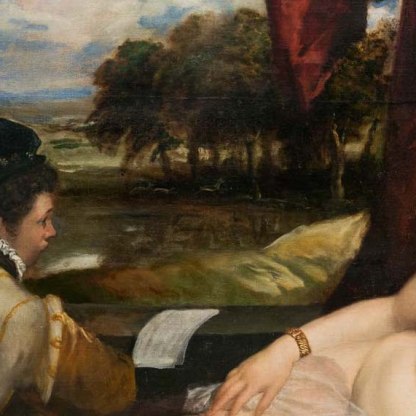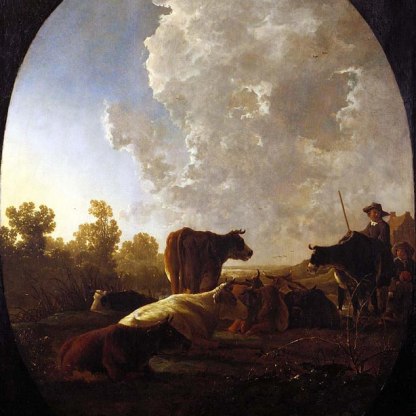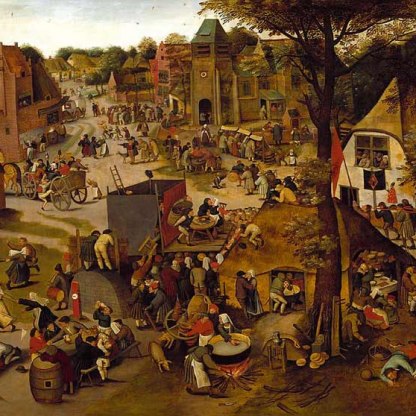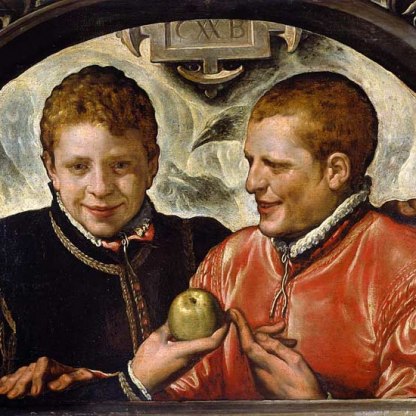The Old Pancake Seller

Jan Steen is the great comedian of seventeenth-century Dutch painting. To this day in Holland a rowdy home is called ‘a Jan Steen household', and he is best remembered for his exuberant scenes set in dining rooms or taverns.
Another painting by him in the Fitzwilliam [73], shows a typically boisterous village festival. His characters swig wine and ale, smoke pipes, flirt, doze drunkenly, laugh, sing and make music. And, as in The Old Pancake Seller, sex is never far beneath the surface.

The title that has been given to this painting is not Steen's own, and is somewhat misleading about the true profession of the woman who grins out at the viewer. It is true that evidence of pancake-making is visible in the foreground – the ladle, the plates, the broken eggshells. But behind the woman is a bed, its curtain folded back to reveal grimy sheets. Food is not the only basic human need being peddled on these gloomy premises. In seventeenth-century Holland, 'cracking an egg into a pan' was a euphemism for sexual intercourse.
The man who has just entered the door has clearly made an effort to impress the seated woman. With his ruff, striped shirt and trousers and doffed red hat, he is absurdly overdressed compared to the other men in the room. And yet there is something of the bumpkin about him – he falls some way short of looking genuinely smart. His shoes are shabby, their laces undone. The raised hat has seen better days, and his flies appear to gape open. Unusually for a prostitute’s client, he proffers a basket of bread. An obscure but suggestively shaped object protruding from his pocket – a sausage? – suggests what is on his mind.
This then does not look like a straightforward brothel transaction. In Dutch paintings and prints from the period, men are usually much more direct in their sexual advances. Here the client's exaggeratedly chivalrous manner, the unusual gift that he bears and, most strikingly, the conspiratorial smile that the woman sends our way, suggest that he is in some way being hoodwinked. Are we being invited to join in a joke at her visitor's expense?
Although the dark appearance of the painting today is in some degree due to its age, Steen seems to deliberately emphasise the dimness in the room. Above the bed, a sconce is set within the wall, but it carries no candle – indeed in the gloom it resembles a serpent. The round window next to it is clogged with ivy. On the wall between the leaded window and the door hangs an unlit lamp with a key beneath it – the key to the picture?
Are we to suppose that the man is being introduced to the woman in a deliberately subdued light, under the pretence that she is younger and more attractive than she really is? Are the two men seated with the woman in on the trick? And who is the soberly dressed old woman framed in the doorway?
Steen was famously interested in the popular theatre, and this painting might reflect a comedy of his day. The narrative would doubtless have been more easily understood by a contemporary viewer. The symbolism too would have spoken more clearly to the seventeenth century Dutchman. Genre paintings by Steen and his contemporaries, while looking like straightforward scenes of everyday life, are often replete with objects that carry hidden meanings, meanings often popularised by proverbs, verse and jokes of the time.
Jan Steen came from a family of brewers and ran a tavern in his home from 1672. It is tempting to imagine that the man himself enjoyed the disreputable pleasures that he so brilliantly paints. In fact there is often a distinct moral message underlying his art. We can be fairly certain that the suitor here will not get away from this experience unscathed; as a popular Dutch saying of Steen’s day went: He who sets one foot in the whorehouse, sets the other in the hospital.'
Themes and periods
Data from our collections database
Acquisition and important dates
- Method of acquisition: Bequeathed
- Dates: 1816
Dating
- 1660s
- Production date: circa AD 1668
Maker(s)
- Steen, Jan Painter
Materials used in production
Read more about this recordStories, Contexts and Themes
Other highlight objects you might like
Suggested Curating Cambridge products
Sign up to our emails
Be the first to hear about our news, exhibitions, events and more…






